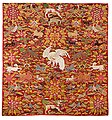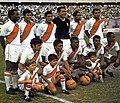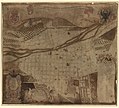Introduction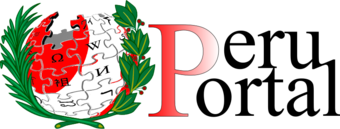
Peru, officially the Republic of Peru, is a country in western South America. It is bordered in the north by Ecuador and Colombia, in the east by Brazil, in the southeast by Bolivia, in the south by Chile, and in the south and west by the Pacific Ocean. Peru is a megadiverse country with habitats ranging from the arid plains of the Pacific coastal region in the west to the peaks of the Andes mountains extending from the north to the southeast of the country to the tropical Amazon basin rainforest in the east with the Amazon River. Peru has a population of over 32 million, and its capital and largest city is Lima. At 1,285,216 km2 (496,225 sq mi), Peru is the 19th largest country in the world, and the third largest in South America. Peruvian territory was home to several cultures during the ancient and medieval periods, and has one of the longest histories of civilization of any country, tracing its heritage back to the 10th millennium BCE. Notable pre-colonial cultures and civilizations include the Caral–Supe civilization (the earliest civilization in the Americas and considered one of the cradles of civilization), the Nazca culture, the Wari and Tiwanaku empires, the Kingdom of Cusco, and the Inca Empire, the largest known state in the pre-Columbian Americas. The Spanish Empire conquered the region in the 16th century and Charles V established a viceroyalty with the official name of the Kingdom of Peru that encompassed most of its South American territories, with its capital in Lima. Higher education started in the Americas with the official establishment of the National University of San Marcos in Lima in 1551. Peru's population includes Mestizos, Amerindians, Europeans, Africans and Asians. The main spoken language is Spanish, although a significant number of Peruvians speak Quechuan languages, Aymara, or other Indigenous languages. This mixture of cultural traditions has resulted in a wide diversity of expressions in fields such as art, cuisine, literature, and music. (Full article...) Entries here consist of Good and Featured articles, which meet a core set of high editorial standards.
Jorge Mario Pedro Vargas Llosa, 1st Marquess of Vargas Llosa (born 28 March 1936), more commonly known as Mario Vargas Llosa (/ˌvɑːrɡəs ˈjoʊsə/, Spanish: [ˈmaɾjo ˈβaɾɣas ˈʎosa]), is a Peruvian novelist, journalist, essayist and former politician. Vargas Llosa is one of Latin America's most significant novelists and essayists and one of the leading writers of his generation. Some critics consider him to have had a larger international impact and worldwide audience than any other writer of the Latin American Boom. In 2010, he won the Nobel Prize in Literature, "for his cartography of structures of power and his trenchant images of the individual's resistance, revolt, and defeat." He also won the 1967 Rómulo Gallegos Prize, the 1986 Prince of Asturias Award, the 1994 Miguel de Cervantes Prize, the 1995 Jerusalem Prize, the 2012 Carlos Fuentes International Prize, and the 2018 Pablo Neruda Order of Artistic and Cultural Merit. In 2021, he was elected to the Académie française. Vargas Llosa rose to international fame in the 1960s with novels such as The Time of the Hero (La ciudad y los perros, literally The City and the Dogs, 1963/1966), The Green House (La casa verde, 1965/1968), and the monumental Conversation in the Cathedral (Conversación en la catedral, 1969/1975). He writes, prolifically, across an array of literary genres, including literary criticism and journalism. His novels include comedies, murder mysteries, historical novels, and political thrillers. Several, such as Captain Pantoja and the Special Service (1973/1978) and Aunt Julia and the Scriptwriter (1977/1982), have been adapted as feature films. (Full article...)Selected image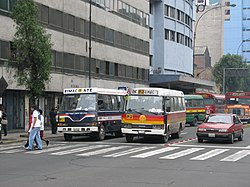 Photo credit: Ericbronder
Public transport in Lima is handled by buses, micros, taxicabs, and the so-called mototaxis. Micros are the most common means of public transportation in Lima and many other cities in Peru. The word micro is used in common-day Peruvian Spanish as an abbreviation for microbus (minibus). These privately-owned vehicles are not only known for being very cheap and convenient but also for being rather risky. (more...) Selected battleThe Cenepa War (January 26 – February 28, 1995), also known as the Alto Cenepa War, was a brief and localized military conflict between Ecuador and Peru, fought over control of a disputed area on the border between the two countries. The indecisive outcome of the conflict — with both sides claiming victory — along with the mediation efforts of the United States of America, Brazil, Argentina, and Chile, paved the way for the opening of diplomatic negotiations that ultimately led to the signing of a definitive peace agreement in 1998, putting an end to one of the longest territorial disputes in the Western Hemisphere. (more...) In this month
General imagesThe following are images from various Peru-related articles on Wikipedia.
Selected article -, also known as the Conquest of Peru, was one of the most important campaigns in the Spanish colonization of the Americas. After years of preliminary exploration and military skirmishes, 168 Spanish soldiers under conquistador Francisco Pizarro, along with his brothers in arms and their indigenous allies, captured the Sapa Inca Atahualpa in the 1532 Battle of Cajamarca. It was the first step in a long campaign that took decades of fighting but ended in Spanish victory in 1572 and colonization of the region as the Viceroyalty of Peru. The conquest of the Inca Empire (called "Tahuantinsuyu" or "Tawantinsuyu" in Quechua, meaning "Realm of the Four Parts"), led to spin-off campaigns into present-day Chile and Colombia, as well as expeditions to the Amazon Basin and surrounding rainforest. When the Spanish arrived at the borders of the Inca Empire in 1528, it spanned a considerable area and was by far the largest of the four grand pre-Columbian civilizations. Extending southward from the Ancomayo, which is now known as the Patía River, in southern present-day Colombia to the Maule River in what would later be known as Chile, and eastward from the Pacific Ocean to the edge of the Amazonian jungles, it covered some of the most mountainous terrains on Earth. In less than a century, the Inca had expanded their empire from about 400,000 km2 (150,000 sq mi) in 1448 to 1,800,000 km2 (690,000 sq mi) in 1528, just before the arrival of the Spanish. This vast area of land varied greatly in culture and climate. Because of the diverse cultures and geography, the Inca allowed many areas of the empire to be governed under the control of local leaders, who were watched and monitored by Inca officials. Under the administrative mechanisms established by the Inca, all parts of the empire answered to, and were ultimately under the direct control of, the Inca Emperor. Scholars estimate that the population of the Inca Empire was more than 16,000,000. (Full article...)Did you know (auto-generated) -
CategoriesRelated portalsSelected quote -
Peruvian writer, politician, journalist, and essayist Jorge Mario Pedro Vargas Llosa
Basic facts & figuresMore did you know...
Peru TopicsRecognized content
Featured articlesFeatured listsGood articles
WikiProjectsThings you can do
New articlesThis list was generated from these rules. Questions and feedback are always welcome! The search is being run daily with the most recent ~14 days of results. Note: Some articles may not be relevant to this project.
Rules | Match log | Results page (for watching) | Last updated: 2024-05-03 21:25 (UTC) Note: The list display can now be customized by each user. See List display personalization for details.
Associated WikimediaThe following Wikimedia Foundation sister projects provide more on this subject:
Discover Wikipedia using portals | |||||||||||||||




